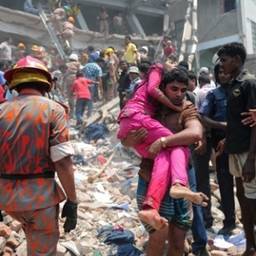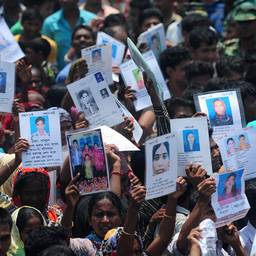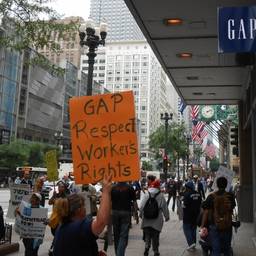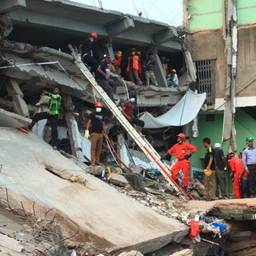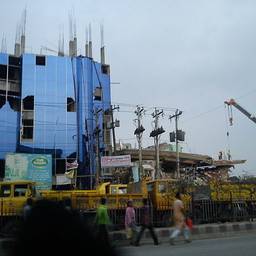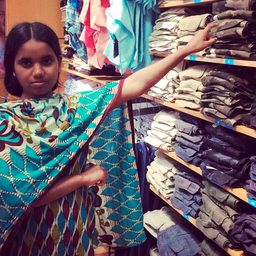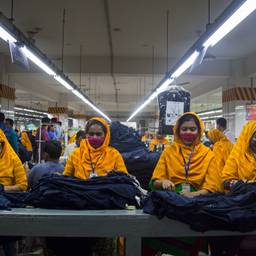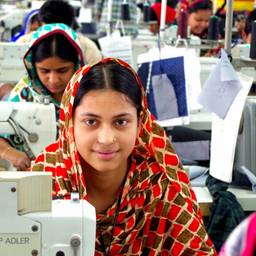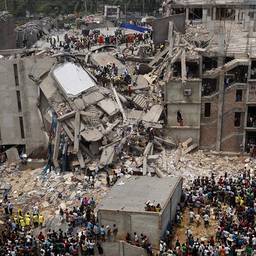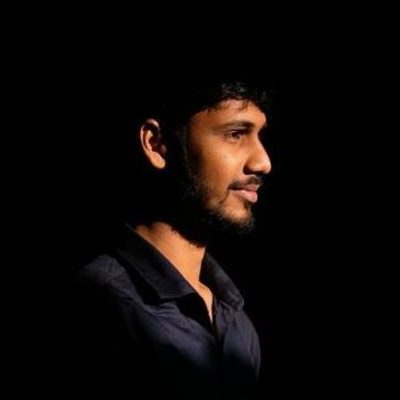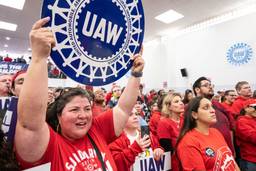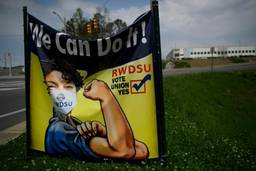10 Years After the Rana Plaza Collapse, Has Anything Changed?
The deaths of 1,100 workers sparked reforms in Bangladesh’s garment industry. But problems persist, especially for those disabled in the collapse.
Piyas Biswas

April 24, 2023, marks the tenth anniversary of the Rana Plaza tragedy in Bangladesh. On that fateful day in 2013, the eight-story building collapsed, killing over 1,100 people and injuring more than 2,500, mostly garment workers who were producing clothes for global brands.
Sumi Akhter, 26, began work at Rana Plaza in April 2013, sewing for garment supplier New Wave Style. She somehow escaped death in the collapse but lost her mother, who worked in the same building. Firefighters rescued Akhter from the rubble of mingled steel and concrete three days after the building collapsed. Her right leg was severely injured and had become gangrenous. To save the rest of her body, doctors had to amputate. Now she has to use a prosthetic leg for walking.
Akhter recalls the day of the tragedy: “In the morning when everyone had entered the building for work, suddenly it collapsed. My coworkers were shouting, urging everyone to run. I tried to run and escape, but somehow I fell down and lost consciousness. When I regained consciousness, I found myself trapped under concrete debris. There were two dead bodies on top of my legs and a concrete beam resting on them.”
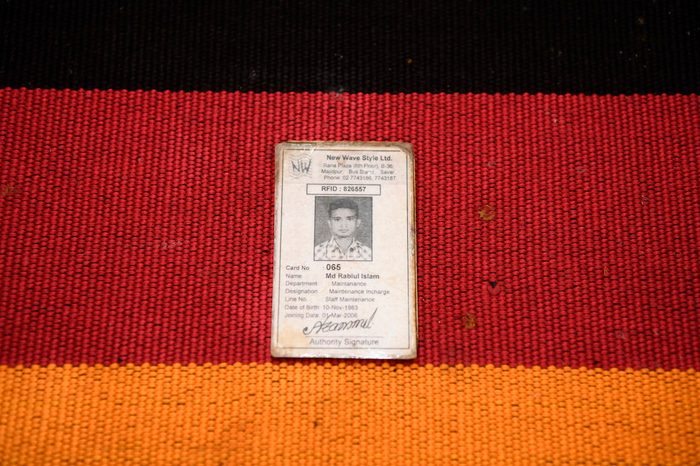
The incident shocked the world and brought the dark realities of the global fast fashion industry to the forefront, sparking calls for change and initiating safety reforms. Bangladesh is the world’s second-largest ready-made garment exporter, after China, supplying more than 300 brands across the globe, such as Walmart, H&M, Zara, Adidas, JC Penney and Uniqlo.
Brands such as Primark, Mango, Benetton and Bonmarché pledged to provide compensation to survivors and to victims’ families, either individually or through the International Labour Organization’s Rana Plaza Donors Trust Fund.
But many of those injured in the collapse, as well as families of those who died, are still suffering hardships a decade later.
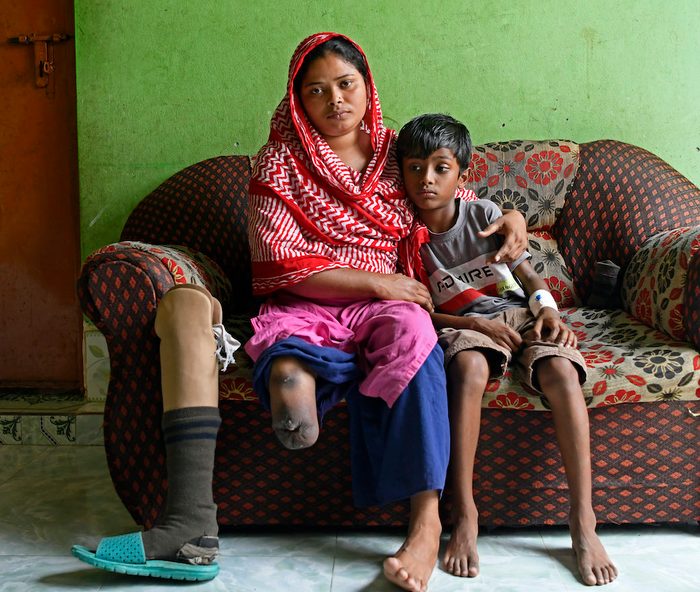
Since the incident, Akhter has been unemployed and needs to change her prosthetic leg every 1.5 to 2 years. While she initially received free prosthetic legs, she had to purchase the most recent one herself by taking out a loan of 90,000 taka ($846).
“Sometimes I feel like it would have been better if I just died there,” she says. “We don’t have that much money to afford new prosthetic legs. Also, I am uncertain about my son’s future.”
Renu Begum, 55, lost her son Robiul Islam Manik in the Rana Plaza accident. He was 27. Robiul worked on the 7th floor as a senior machine mechanic and was the family’s main bread earner.
“The owner of the factory has never checked on us or provided any financial assistance, not even a minimal amount,” says Begum. “If my son were still alive, our struggles wouldn’t be as difficult. Both my husband and I are ill and unable to work. If the owner had chosen to close the factory upon seeing the cracks in the building the day before the collapse, none of these would have happened. The owner is not lacking in wealth, so why did they not take action to shut down the factory?”

A recent survey by ActionAid Bangladesh found that 54.5% of Rana Plaza survivors are currently unemployed, and 89% of them have been jobless in the past five to eight years.
Mahmudul Hasan Hridoy, president of the Savar Rana Plaza Survivors Association of Bangladesh, says some survivors now beg for a living.
Since the tragedy, there has been a notable shift in attention toward worker safety in Bangladesh’s readymade garment industry. The European-led Accord on Fire and Building Safety in Bangladesh, a legally binding agreement between global brands, trade unions and NGOs, was established in 2013 to inspect and remediate garment factories for fire, electrical and structural safety. The Accord has made significant progress, inspecting over 1,600 factories and helping to remediate safety violations in many of them.
Similarly, the U.S.-led Alliance for Bangladesh Worker Safety, a consortium of North American brands and retailers, conducted safety inspections and remediation efforts in more than 700 garment factories. Together, these efforts have resulted in closing unsafe factories, renovating others and improving working conditions for millions of workers. They have addressed issues such as electricity and fire safety, infrastructure risks, workers’ health, freedom of association, and the overall working environment.
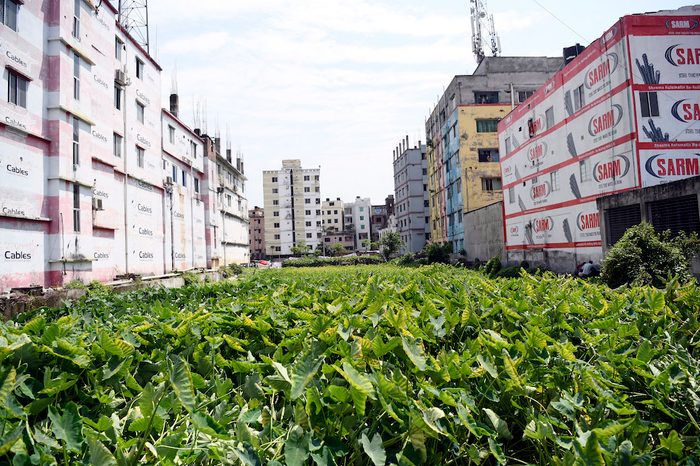
Despite the progress made, many challenges remain.
In 2018 the Alliance handed over operations to Nirapon, an NGO, and in 2021 the Accord transferred its operations to the RMG Sustainability Council, a committee of factory owners, unions and global brands. But reportedly, there are concerns that RSC may not be as effective as Accord in terms of safety monitoring.
The safety inspection groups don’t monitor subcontractor factories, which are contracted by larger manufacturers for specific stages of production, such as cutting or sewing. These factories number more than 1,000 and employ 220,000 workers.
Asked about this issue, Bangladesh Garment Manufacturers and Exporters Association (BGMEA) President Faruque Hassan said, “We have instructed our member factories to only hire subcontractors that comply with safety regulations and take approval from the retailer client before hiring.”
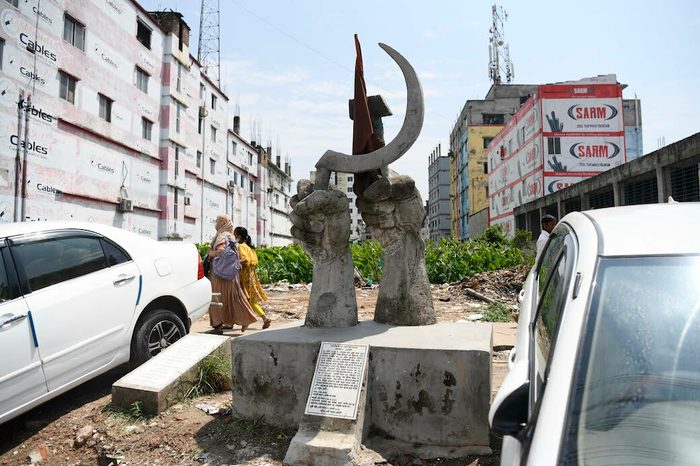
Low wages have not drawn the same attention as safety concerns. Rozina Begum, 25, a junior swing operator working in a garment factory, earns a monthly salary of 10,000 BDT ($95) and makes up to 13,000−14,000 ($123-$133) with overtime. She says it is tough to afford basic necessities, especially with inflation. “The cost of everyday things has gone up.”
Working 10-14 hours a day to earn extra money is common, and deleterious to workers’ health, says Amirul Haque Amin, president of the National Garments Workers Federation (NGWF), which represents more than 100,000 workers and has 99 registered affiliates and 1,261 factory committees.
Workers also face challenges when they are sick or injured. “Sick leaves are counted as absences,” says Amin, and workers also don’t always get compensation or treatment for workplace injuries. But he’s optimistic about a new workers’ compensation pilot initiative launched with the help of the German and Netherlands governments. The program will cover 4 million garment workers.
The Accord emphasized the ongoing need for effective worker representation in factories. Although workers are technically free to form trade unions, many are hesitant to do so since they still face threats, intimidation, and harassment for exercising their right to freedom of association.
The COVID-19 pandemic made things harder for readymade garment workers. Many lost their jobs due to factory closures and reduced demand for clothing. To help, the government and international organizations launched initiatives like cash transfers and hotlines for labor rights. But these efforts had limited funding and failed to reach all affected workers.
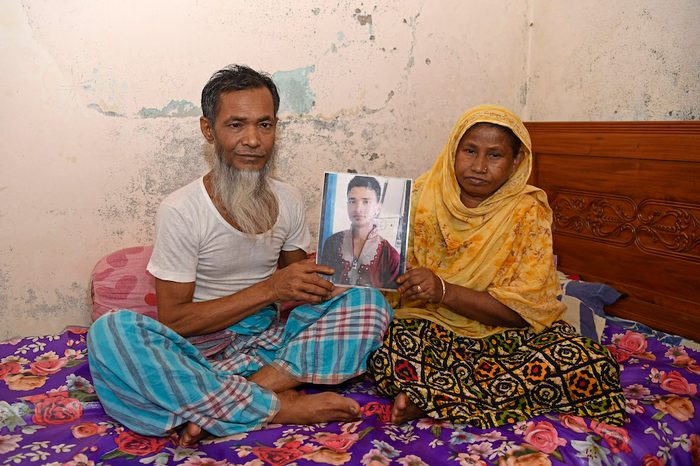
After the 2013 disaster, U.S. garment imports from Bangladesh briefly dropped when the U.S. withdrew “favored” trading partner status. But after the safety reforms, imports rose again. In recent years, the U.S. trade war with China has spurred U.S. imports of Bangladeshi garments even higher, from $7.5 billion in 2021 to $10 billion in 2022.
Ultimately, international brands choose Bangladesh as a sourcing destination due to low labor and production costs. However, this results in factory owners cutting costs by exploiting workers.
Hridoy believes this will continue as long as workers don’t have representation.
“The same individuals who own the garment factories also hold positions in the parliament and cabinet,” says Hridoy. “There is no representative of the workers in the parliament. The rulers are exploiting [us].”
Piyas Biswas is a visual journalist from Dhaka, Bangladesh. His work has been published by media such as The Guardian, The Wall Street Journal, CNN International and BBC Bangla. His focus is on climate change, human rights, political conflicts and other social issues. He uses his vision to document humanity and raise awareness of global issues.
